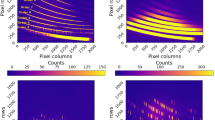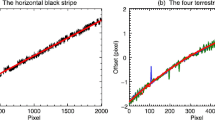Abstract
This paper presents a description of the pipeline reduction of low and medium resolution spectral data obtained in the long-slit mode of the multi-functional Robert Stobie Spectrograph (RSS), mounted on the Southern African Large Telescope (SALT). The paper describes features of RSS that result in the creation of the pipeline. The main ideas of the developed pipeline are presented together with a general description of the pipeline and detailed description of its steps. The flow diagrams of all the pipeline steps are shown as well.







Similar content being viewed by others
Notes
All the SALT reports that the author references in this article are collected in https://www.saao.ac.za/akniazev/pub/RSS/. Some of them are also referenced in http://pysalt.salt.ac.za/proposal_calls/current/ProposalCall.html.
In this particular case, the author interprets efficiency as the fastest way to create and debug working programs used by the author to reduce long-slit spectra.
The light sources for the flat fields are two continuum spectrum lamps mounted in the telescope’s calibration system. There is a single location for all calibration sources of all scientific instruments, the light from which is fed into the telescope’s beam by a special mirror that overlaps the signal path of the object.
For details see Sections 5 and 7.10 of the document http://pysalt. salt.ac.za/proposal_calls/current/ProposalCall.html.
IRAF/PyRAF assumes that any task call is a single line. Breaking it up into separate lines here is done purely for the sake of convenient display. Also, it should be kept in mind that all parameters can be set interactively by calling epar task_name.
REFERENCES
V. L. Afanasiev and A. V. Moiseev, Astronomy Letters 31 (3), 194 (2005).
S. I. Barnes, P. L. Cottrell, M. D. Albrow, et al., SPIE Conf. Proc. 7014, id. 70140K (2008).
D. G. Bramall, J. Schmoll, L. M. G. Tyas, et al., SPIE Conf. Proc. 8446, id. 84460A (2012).
D. G. Bramall, R. Sharples, L. Tyas, et al., SPIE Conf. Proc. 7735, id. 77354F (2010).
D. A. H. Buckley,G. P. Swart, and J. G.Meiring, SPIE Conf. Proc. 6267, id. 62670Z (2006).
E. B. Burgh, K. H. Nordsieck, H. A. Kobulnicky, et al., SPIE Conf. Proc. 4841, pp. 1463–1471 (2003).
L. A. Crause, R. M. Sharples, D. G. Bramall, et al., SPIE Conf. Proc. 9147, id. 91476T (2014).
S.M. Crawford,M. Still, P. Schellart, et al., SPIE Conf. Proc. 7737, id. 773725 (2010).
P. Grosbøl and D. Ponz, in Proc. Int. Workshop on Acquisition, Processing and Archiving of Astronomical Images, Astronomical Observatory of Capodimonte, Naples, Italy, 1990, Ed. by G. Longo and G. Sedmak (OfficineGrafiche Liguori, 1990), pp. 111–123 .
A. Y. Kniazev, Candidate’s Dissertation in Mathematics and Physics (SAO RAS, Nizhnij Arkhyz, 1997).
A. Y. Kniazev, Long-slit reduction with SHyRAF package RELSA, SALT Report (2006).
A. Y. Kniazev, SALT Long-slit Data Reduction, SALT Report (2008).
A. Y. Kniazev, Atlas of Reference Spectra for RSS Observations, SALT Report (2009).
A. Y. Kniazev, RSS: Radial Velocity Accuracy using Emission Lines, SALT Report (2012).
A. Y. Kniazev, Automatic gain correction algorithm for the RSS mosaic CCD, SALT Report (2019).
A. Y. Kniazev, Gain calculation for the RSS CCD, SALT Report (2020a).
A. Y. Kniazev, RSS CCD mosaic gains up to now, SALT Report (2020b).
A. Y. Kniazev, E. K. Grebel, S. A. Pustilnik, et al., Astron. J. 127 (2), 704 (2004).
A. Y. Kniazev, I. A. Usenko, V. V. Kovtyukh, and L. N. Berdnikov, Astrophysical Bulletin 74 (2), 208 (2019).
H. A. Kobulnicky, K. H. Nordsieck, E. B. Burgh, et al., SPIE Conf. Proc. 4841, pp. 1634–1644 (2003).
H. Lorenz, G. M. Richter, M. Capaccioli, and G. Longo, Astron. and Astrophys. 277, 321 (1993).
D. O’Donoghue, D. A. H. Buckley, L. A. Balona, et al.,Monthly Notices Royal Astron. Soc. 372 (1), 151 (2006).
P. G. van Dokkum, Publ. Astron. Soc. Pacific 113 (789), 1420 (2001).
J. Vennik, U. Hopp, B. Kovachev, et al., Astron. and Astrophys. Suppl. 117, 261 (1996).
ACKNOWLEDGMENTS
I dedicate this work to the memory of my good friend, astronomer and science popularizer Oleg V. Verkhodanov. The author acknowledges support from the National Research Foundation (NRF) of South Africa. The author would also like to thank the reviewer for his careful reading of the text and advice on how to improve. Spectral observations that were used to verify and debug the RSS spectral pipeline were obtained on the author’s (PI: Kniazev) SALT applications:
2010-1-RSA-004, 2010-1-RSA-007,
2010-1-RSA_OTH-001, 2011-3-RSA-003,
2010-1-RSA_OTH-002, 2010-1-RSA_OTH-012,
2010-1-RSA_OTH_013, 2011-3-RSA_OTH-001,
2011-3-RSA_OTH-002, 2012-1-RSA-001,
2012-1-RSA_OTH-001, 2012-1-RSA_OTH-002,
2012-2-RSA-001, 2012-2-RSA_OTH-002,
2012-2-RSA_OTH-003, 2012-2-RSA_OTH-004,
2013-1-RSA_OTH-008, 2013-1-RSA_OTH-014,
2013-2-RSA_OTH-003, 2013-2-RSA_OTH-005,
2014-1-RSA_OTH-005, 2014-2-MLT-001,
2015-1-SCI-017, 2015-1-SCI-030,
2015-2-MLT-002, 2015-2-MLT-004,
2015-2-SCI-022, 2015-2-SCI-043,
2016-1-MLT-002, 2016-1-MLT-003,
2016-1-MLT-005, 2016-1-SCI-012,
2016-1-SCI-019, 2017-1-MLT-001,
2017-1-MLT-005, 2017-1-SCI-006,
2017-2-DDT-002, 2017-2-MLT-001,
2018-1-MLT-003, 2018-1-MLT-008,
2018-2-MLT-001, 2019-1-MLT-002,
2019-1-MLT-005, 2019-1-SCI-003,
2019-1-SCI-004, 2019-1-SCI-007,
2020-1-MLT-001, 2020-1-MLT-003,
2020-1-SCI-002, 2020-1-SCI-005.
Author information
Authors and Affiliations
Corresponding author
Ethics declarations
The author declares that there is no conflict of interest.
Rights and permissions
About this article
Cite this article
Kniazev, A.V. Pipeline Reduction of Long-Slit Spectra Obtained with the SALT Telescope. Astrophys. Bull. 77, 334–346 (2022). https://doi.org/10.1134/S1990341322030075
Received:
Revised:
Accepted:
Published:
Issue Date:
DOI: https://doi.org/10.1134/S1990341322030075




